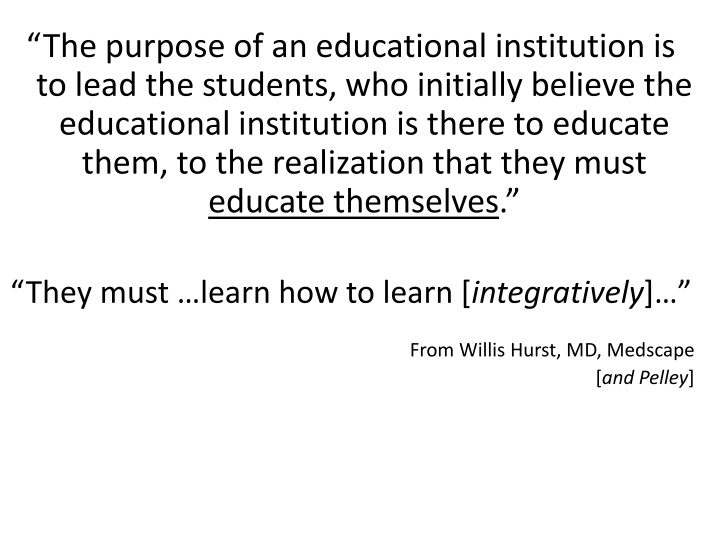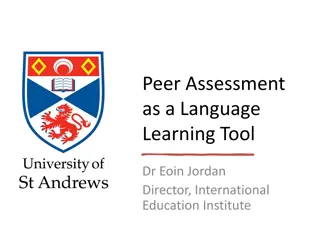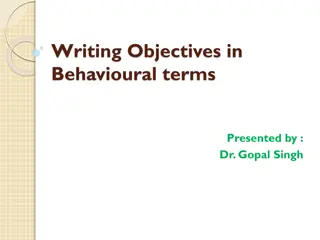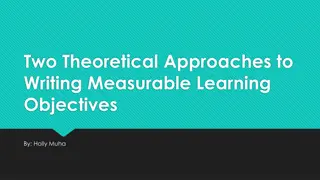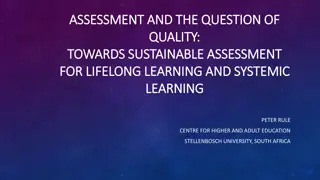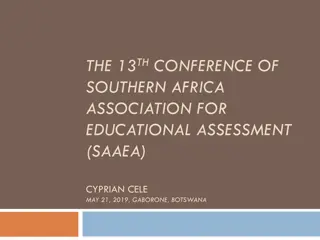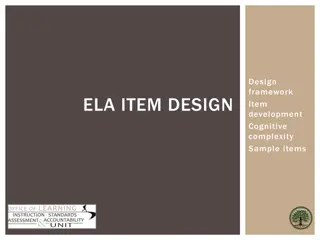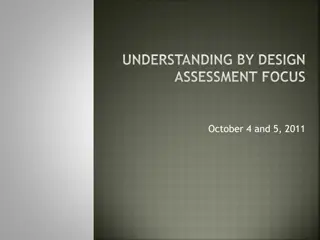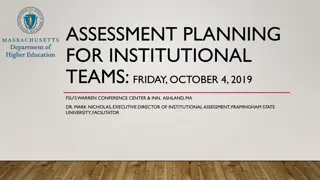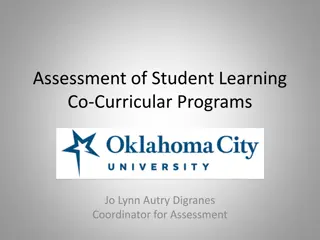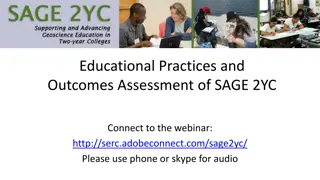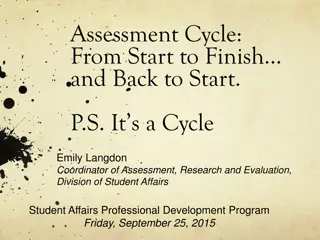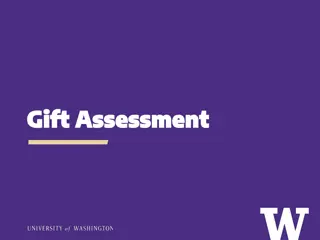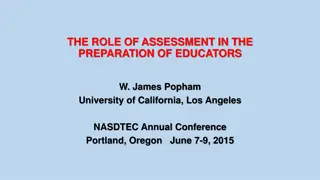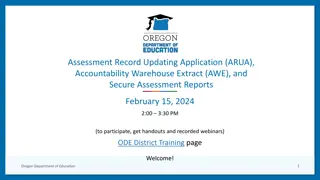Enhancing Educational Objectives and Assessment Strategies
Educational institutions must guide students to self-education by emphasizing the importance of learning how to learn. This involves setting clear objectives, measuring outcomes, and evaluating effectiveness through testing and evaluation methods. The process includes defining learning expectations, designing effective test questions, and aligning objectives with different types of learning. Ambiguity in objectives can impact reliability and validity, highlighting the importance of clarity in educational goals.
Download Presentation

Please find below an Image/Link to download the presentation.
The content on the website is provided AS IS for your information and personal use only. It may not be sold, licensed, or shared on other websites without obtaining consent from the author.If you encounter any issues during the download, it is possible that the publisher has removed the file from their server.
You are allowed to download the files provided on this website for personal or commercial use, subject to the condition that they are used lawfully. All files are the property of their respective owners.
The content on the website is provided AS IS for your information and personal use only. It may not be sold, licensed, or shared on other websites without obtaining consent from the author.
E N D
Presentation Transcript
The purpose of an educational institution is to lead the students, who initially believe the educational institution is there to educate them, to the realization that they must educate themselves. They must learn how to learn [integratively] From Willis Hurst, MD, Medscape [and Pelley]
Writing Course and Clerkship Objectives John W. Pelley, PhD www.ttuhsc.edu/SOM/success
Mind Bender Talk to a neighbor to answer, Is a test question an expectation or an outcome? And, Are testing and evaluation the same thing?
The Learning Cycle Some Motor Skills Sensory Skills Thinking Skills Memory Skills 4 Zull, 2002, The Art of Changing the Brain
Expectations vs. Outcomes Objectives state learning expectations How well have the students used their brains? Testing measures learning outcomes Evaluation compares expectations vs. outcomes Applies to teacher and students Therefore, Testing is what happened Evaluation is what it means Objectives help evaluation
Test Questions Are Outcomes After The Test Reliable and valid measure of: teaching effectiveness learning effectiveness memory skills thinking skills Ambiguity in objectives affects reliability and validity.
Test Questions Are Expectations Before The Test Test questions are also learning objectives. Learning objectives are most easily written as short essay test questions. Long essay questions are too vague. Effective objectives help in writing effective test questions!
Objectives For Different Kinds Of Learning State what you want the student to be able to do in an essay question format. Ask for Written skills (e.g. typical study notes), Oral skills (e.g. interviewing), or Psychomotor skills (e.g. physical examination).
Example of Ambiguous Learning Objective Faculty will be able to modify course goals and objectives based on the principles taught at this session. But, why would I need to modify my objectives? Also, what kind of objectives am I writing teaching objectives or learning objectives? And, will the modifications be an improvement? For who? Conclusion: This objective doesn t mean the same thing to everybody.
Better Learning Objective For a given topic, participants will be able to determine the appropriate content to be learned. determine the appropriate level of complexity to be learned. compose a written objective that specifies a mental or physical behavior.
Restated As Essay Questions Learning Objectives For a given topic describe the appropriate content to be learned. describe the appropriate level of complexity to be learned. compose a written objective that specifies a mental or physical behavior.
GRIPE Objectives Sample Compare: coagulative necrosis; liquefactive necrosis; gangrenous necrosis; caseous necrosis; fat necrosis; fibrinoid necrosis; and apoptosis in terms of: 1. common sites or tissues involved and reasons for this 2. common causes or causative mechanisms 3. gross and microscopic appearance 4. types and extent of healing (GRIPE = Group for Research in Pathology Education) 12
Learning Objectives Produce Teaching Objectives If you think about the outcome (learning objectives), the teaching process will automatically follow. Learning objectives help us teach thinking. write better test questions.
Levels Of Learning (Complexity) Memorization skills Recall (linear thinking) Just the facts ma am HOTS (Higher Order Thinking Skills) Analysis (grouping, indexing) How are facts grouped into patterns? Comparison (patterns) How are patterns related? Inference (concluding) What is deduced? [diagnosis] Evaluation (future vision) What is predicted? [clinical treatment and management]
Learning Objective Examples Recall Define hyperglycemia, ketoacidosis, glycosylation Analysis Give the characteristics of type 1 diabetes. Comparison Explain how type 1 and type 2 diabetes are both similar and different. Inference Explain your diagnosis of type 2 diabetes. Evaluation Justify a treatment plan for a type 2 diabetic.
Pre-frontal Pause Which level is most important? Recall Analysis Comparison Inference Evaluation Talk with a neighbor for 1 minute to decide.
Recall Level Objectives List the ________ . Describe ________. Define the term ________. Name ________.
HOTS Objectives Explain how the conclusions are supported by the data/facts/evidence. Compare (symptoms) before and after (procedure) . Classify ________ according to ________ . Distinguish ________ from ________. Explain how ________ works. Predict what will happen if (treatment).
Easier Objective Writing From NBME Question Templates Use the NBME question templates in the handout materials Creating Effective Learning Objectives and Test Questions . www.nbme.org Item writers guide contains question templates
Sample NBME Question Template Insert patient vignette describing a patient with a problem. Which of the following is the vessel into which contrast medium should be injected during fluoroscopy to visualize the site of the abnormality? Question form: Which of the following is the vessel into which Objective form: Explain where and why
A word of caution If an objective requires a response that has been explicitly taught, it is actually testing only rote memory (recall). A HOTS objective mustrequire the student to generalize or apply what he or she knows to a new situation.
Recall Sample Questions List the ________ . Define the term ________. What is a ________? Who did ________? Name ________. Note: Any question becomes a recall question if the answer has already been explicitly provided to the student in class or in the text.
Recall Trigger Words define list name identify who what when
Analysis Sample Questions Classify ________ according to ________ . Explain how ________ works. What kind of a ________ is this? What is the function of ________ ? What is the relationship between ____ and ____ ? (classification/grouping relationships)
Analysis Trigger Words break down relationship how it works how it's used give an example
Comparison Sample Questions How is ________ like ________ ? How are ________ and ________ different? Compare the _____ before and after ______ . Distinguish between _______ and ________ . Compare ________ with ________ . Which one is the best/worst?
Comparison Trigger Words compare contrast distinguish alike different
Inference Sample Questions Hypothesize what will happen if ________ . Predict what will happen if ________ . Solve the problem ________ . What if ________ ? What rule applies here? What generalization can you make from this information?
Inference Trigger Words hypothesize synthesize use (provide evidence found ) apply (state a rule ) generalize what if conclude solve
Evaluation Sample Questions Why was the argument convincing? Did ________ behave/respond appropriately? Why? What would you have done in this situation? Why? Was this experiment well designed? Defend your answer. Judge which is the best solution to the problem. Why do you think so? How well are the conclusions supported by the data/ facts/evidence? Explain. Which ________ is the best? Why do you think so?
Evaluation Trigger Words judge evaluate best solution justify defend critique defend
